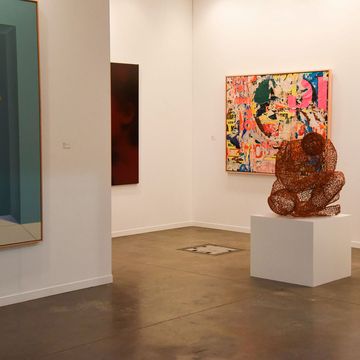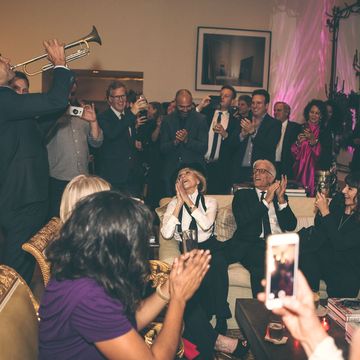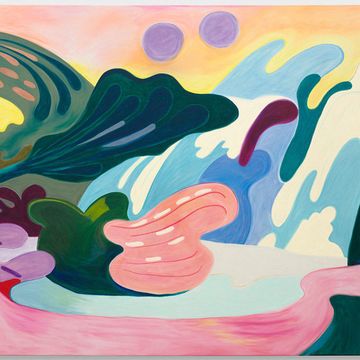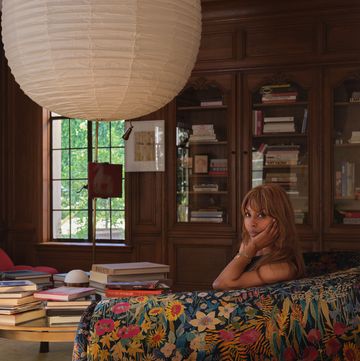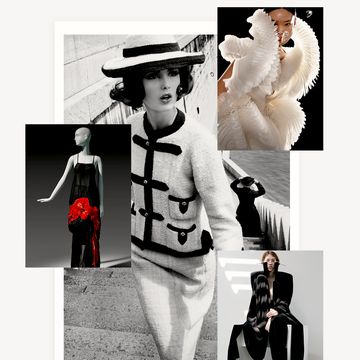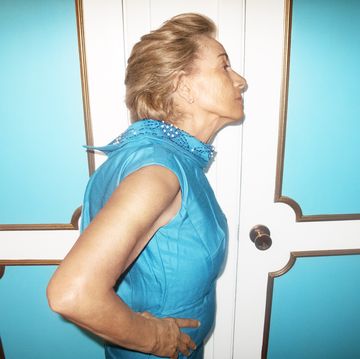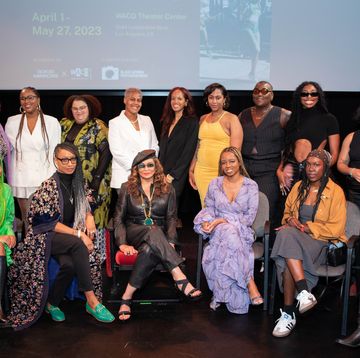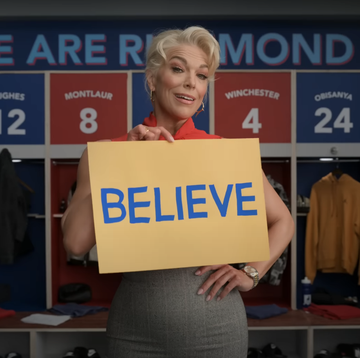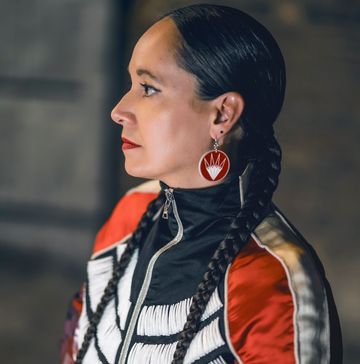While reading the New York Times yesterday, we stumbled upon an article reexamining the controversy surroundingRed, Black & Silver—a small canvas attributed to Jackson Pollock, or so alleged by "Jack the Dripper's" late mistress, Ruth Kligman. The debate over the piece's authenticity has outlived both Pollock and Kligman, but the article instantly reminded us of a profile of the colorful Ms. Kligman published in the October 1999 issue of Mirabella magazine, back when our editor in chief Robbie Myers held the top spot there. Herewith, writer Will Blythe's full story of the twentieth century art scene's most seductive muse.
At summer dusk in her studio, the light fading to a monochromatic New York gray, Ruth Kligman is listening intently to Ruth Kligman. She is reading aloud a love letter she has recently written to a man who has been dead for forty-three years. "Jackson, Jackson, Jackson," she begins, her voice trembling with a certain actressy gusto. "I loved you so much and I made you the promise to keep that love always, and I did just that, kept my word, for me, for you." She reads on, stopping periodically to look up at me and exclaim, "It's beautiful, isn't it?" Barefoot, recumbent on her bed in a tea-length black dress, propped up on pillows, she looks every inch the professional (if funkified ) widow.
She's actually not the widow, not literally anyway, but such details are for the small-minded—for Ruth Kligman loved him last and best, and had he lived, they would have been married. She assures me of that.
At one point, the curtains flare into the studio with an explosive pop. "Did you see that? That was him coming in," Kligman tells me. "He protects me. Whenever I give interviews, doors swing open, the electricity goes off, engines shut down." The "he" in question is Jackson Pollock, perhaps the greatest American painter, tagged "Jack the Dripper" by the wits at Time magazine, a homegrown manic genius who flung his psych full-force onto the canvas, pouring out lyrical, spooling traceries of desperate energy.
Given the force field that surrounded him in life, it doesn't seem so implausible that he might exert poltergeistic powers after death, especially in this bedroom so largely devoted to his memory. It has the feeling of a shrine, a Spanish botanica filled with candles and the images of the saints and the dead. Pollock, of course, is both saintly and dead, an icon of purity for this era of hype, and in the way of purists who live (and drive) fast, die young, and leave a pretty (bloated) corpse, he is soon to be the subject of a major motion picture, directed by and starring Ed Harris. Pollock was the first American celebrity artist, and naturally, the first celebrity artist to flee from his celebrity. Hold his story up to the light, turn it whichever way you will, and it can serve as an object lesson for almost anything—the ravages of demon rum (or six-packs all the livelong day), the devouring of the artist by the wolves of commercialism, a foreshadowing of the perils of celebrity culture, the comedy of psychoanalysis in its American heyday, and on and on.
But for Kligman, his story is her story, a love story. An acquaintance, the composer Ned Rorem, describes her account of the romance, Love Affair (being reissued this fall by Cooper Square, with her love letter to serve as the introduction), as "one narcissist depicting another." ("I think that's because he's a narcissist," Ruth says.)
Above the doorway to the bedroom is a photograph of Kligman astride Pollock's knee. A painter herself, she has embroidered the border of the print with her own squiggly brushwork. The effect is somewhere between a grown-up's handmade memorial and a high school sophomore's doodling around the yearbook picture of a crush. On the day of the snapshot--August 11, 1956—Pollock had been drinking since early that morning, and Kligman had been working hard to lighten his mood. But in this moment, at least, sitting on a boulder in the broad summer light of the Hampton's they're putting on a spirited face for the camera. The picture was taken by her friend Edith Metzger at two o'clock in the afternoon of Pollock's "death-day," as Ruth calls it.
Oh the floor elsewhere in the studio sits a painting of Pollock's entitled Red, Black & Silver, what she calls the last he ever did, which he gave Ruth just weeks before his death. She's thinking about selling it. At sixty-nine, having been a painter and a lover all her life (sadly, there are no pensions for those pursuits), she could use the money.
The earthly aspect of Kligman and Pollock's romance expired at its rocky peak on Fireplace Road in East Hampton, Long Island, on the night of the picture, when Pollock, drunk, took a curve too fast and cartwheeled his convertible into trees, killing himself and Metzger and severely injuring Kligman. Pollock was forty-four, Kligman twenty-six; they had been in love only months. "At the moment he died, I believe his soul went into my body," Kligman says. For her, the divide between the spirit world and this one is about as thick as a stretched canvas. "And when I was convalescing into the hospital, he came and visited me."
The New York art world, where there had been much disapproval of the liaison, sometimes reacted as if the wrong person had lived. In the wreck's aftermath, the poet Frank O'Hara nicknamed Kligman "Death Car Girl," a sobriquet that apparently stung. (When O'Hara died, says a friend who knew them both, Ruth composed a poem that went like this: "You called me Death Car Girl/But look who's dead now.")
Here in Kligman's apartment, the light in the room grows dimmer, encouraging more confession. We are, fittingly, turning into abstractions of ourselves, little blobs of luminosity trading our woeful tales of love. Kligman picks up the letter to read on. Despite her self-absorption, a quality of which she's well aware ("I'm fascinated by myself and I know it," she says), the performance is moving. The narcissism of adolescence can charm again from one approaching seventy.
In the near-darkness, Kligman looks in my direction. It seems that she is crying, but it's hard to tell. "You never stop," she says. She means, I'm sure, you never stop loving, even after forty-three years of irrevocable absence. She snaps on the lights, leads me to the door. We pass through the narrow kitchen, where a Larry Rivers drawing of Ruth rests atop the counter. The we arrive at what can only be called The Wall of Kligman, an entire gallery's worth of photographs devoted to herself. That's Ruth and Williem de Kooning in 1959, sunning themselves on a Long Island beach. That's Ruth and Jasper Johns in 1986 at her gallery show, their arms around each other, beaming at the camera. ("She was good," says an acquaintance. "She didn't just stop at straight guys.") There's Ruth with Franz Kline, whose studio this once was. There's Ruth looking remarkably like Elizabeth Taylor, to whom she's often been compared. Here's Ruth in 1980, photographed by Robert Mapplethorpe. That's Ruth by Irving Penn, by Timothy Greenfield-Sanders, by Bert Stern, by Rudy Burkhardt. It strikes me as very impressive, if not a little prematurely posthumous.
The next time we see each other, after upbraiding me for not calling her when I said I was going to ("You're a man, you probably didn't even know you did it," she says teasingly), Ruth Kligman gets right to the mystery that is haunting her: "Why did Jackson want to know me? Why did they all want to know me? Why was I there?"
It's a karmic question, to be sure, with a pardonable touch of preening. After all, her little black book could pass for an Abrams's guide to twentieth-century painting.
Tonight, in a flowing white dress, Kligman positively radiates queenliness. The staff at the restaurant where we're having supper treats her with a sort of vexed deference, unsure of whether she's someone they should know. She had lobbied for the Four Seasons or Le Cirque, but we have ended up downtown at Il Cantinori, a restaurant in Greenwich Village, just scant blocks from where she met Pollock one evening in 1956 at the Cedar Street Bar (despite the name, then located at Eighth Street and University Place), a now-legendary artists' hangout where, as is customary in such places, thousands of masterpieces were painted by hand in the smoky air during nights of drunken talk, then never quite re-created with the same bravura the next hungover morning in the studio. With Pollock then occupying the Ernest Hemingway Papa Bear Chair of the art world, his arrival had electrified the joint. Patrons, themselves enlarged by a genius in their midst, secretly hoped to witness a brawl--Pollock was known to randomly punch people out, often famous artists--or some other memorable atrocity, such as the time ripped the bathroom door off its hinges. (And before that, on the Upper East Side, he had wandered into a cocktail party at the collector PEggy Guggenheim's peed into the fireplace, and wandered out again. Drunken genius has always had its privileges, especially when it's not your fireplace.)
"He was having a hell of a time," Jackson's friend, the painter James Brooks, has said. "Lee was pretty good at bringing him down…. He felt good about [Ruth]—you know, a pretty, voluptuous gal, thinking he was the greatest man in the world, and in love."
Even today, Kligman purveys an oxymornic blend—the hauteur of an alluring woman who knows her own beauty with the child of divorce's eagerness to please, especially Baddy. For someone so admittedly electrified by the high voltage of self, Kligman nonetheless inspires those around her to shine.
"The minute I saw Jackson, I knew him better than anyone in the world," Kligman says. "I already knew his work. He was expressing the way I feel. I said to him, 'You are the greatest painter in the world. Why are you crying?' He would be stunned. I would say to him, 'Don't you know what you've done?' He didn't understand how I knew what he's done. I mean, it wasn't Clem Greenberg saying it, it was me. He knew that I knew something. Bill de Kooning knew, too. They all did. That's why they gravitated to me. See, I thought it was my appearance, but it was this other quality—my intuition."
That spring, Pollock and Kligman would meet in bars and her apartment whenever he would come into the city from his home in East Hampton in order to visit his shrink. As the affair progressed, they began spending more time together on Pollock and his wife's home turf, the Hamptons, which in those days was not the posh celebrity summer camp it is today but sort of rural Greenwich Village, where artists could find a cheap house and work in relative isolation under the high Atlantic Light. Early one morning that summer, Brasner caught her husband and Kligman sneaking out of a barn next to their home, giggling as they went, and delivered Pollock the usual ultimatum: her or me. Krasner then departed to Europe for six weeks, perhaps hoping that the affair would cool off when the two paramours had each other all to themselves.
Pollock immediately installed Kligman in the farmhouse he and Krasner shared. As Pollock's friend, the late Hamptons fixture Patsy Southgate, told his biographer Jeffrey Potter, Pollock's "dream was to have both" women. But he sensed the local community's disapproval, an attitude encapsulated in one wife's depiction of Kligman as an "art bobby-soxer." The couple were thrown back on their own company. Yet as claustrophobic and harrowing as their East Hampton sojourn often was, Kligman has largely colorized the stark film of those weeks.
"I'm like Cleopatra," she says, "and Jackson was like Marc Anthony. I think I had met him before; he was a very deep soul mate. Nothing else could explain why I've been involved with him over the years. He died in my arms."
"He died in your arms?" I had been under the impression that Pollock had been killed instantly when he slammed headfirst into a tree, ten feet up the trunk. When rescuers arrived, they found Ruth, who had also been thrown from the car, pulling herself down the road on her stomach, calling for Jackson.
"Well, what I mean is, an hour before he died, he had been in my arms, crying."
"What do you think would have happened had he lived?"
"If he hadn't died," says Kligman, "we would have gotten married.
That's what he wanted. He wanted to start over. He was only forty-four. He had lived a certain way all his life, but it was hurting his art. He wanted a sweeter romantic life. The resentment and the publicity had isolated him. Lee Krasner and Clem Greenberg liked him when he was down and out. I tried to break off with him. I told him I had this feeling we would probably die in a car wreck. But I couldn't do it. All these years, I've been blaming myself for what happened. I bought the myth that I was the seductress, that everything was my fault, that I killed Jackson Pollock. But he manipulated the separation [from Lee]."
I wonder if Ruth ever had any contact with Krasner, who has been dead since 1984. She sighs. "I tried to. I went up to her at a party back in the '60s. I said, 'Jackson really cared about.' She said, 'Thank you for telling me.' Then over the years, she got really angry with me.
"I am the last one alive who really knew him," she says, as proudly as a war widow. "What is the destiny that I have, that I met him? I want someone to tell me."
She looks at me, half-imploringly, half-expectantly. She is still almost voodooishly youthful and attractive. "Maybe by dessert," I offer.
In 1957, a year after Pollock's death, Kligman became involved with perhaps the second most famous American painter of the twentieth century-the Dutch immigrant Williem de Kooning. Pollock and de Kooning were affectionate rivals, Pollock once telling de Kooning, "You know more, but I feel more."
De Kooning also apparently felt some affection for Ruth, having once chased Pollock and Kligman down the block outside the Cedar Bar, shouting, "Hey, Jackson, is that your new girl? Let me take a look." Of Pollock's relationship with Kligman, de Kooning said, "she must have cared for him a lot—kind of cared for me, too, later. She meant it but not like, you know, a great passion or anything like that. She was starting to paint, and she wasn't stupid about it, either…. She could have become a painter, but nobody takes a person very seriously when they're just starting to paint, particularly if it's a woman."
Their relationship lasted four years. Like Kligman, de Kooning also hated middle-class life, what he called "the couples." "Bill and I would stay up all night talking about Rothko or technique," Kligman says. "And every morning at breakfast, he read philosophy—Wittgenstein, Kierkegaard. He reminded me a lot of Chaplin—very funny, witty, really intelligent.
"He always said I was the only woman who never bored him. He said I melted him. It was a beautiful love affair. He brought me tulips. Being involved with him was like getting a Ph.D. in art history. 'Tell me more, tell me more,' I'd say. He called me his sponge. He would always say, 'Compete with me.' He didn't want a woman to be a slave. He built me a painting wall. He'd look at my painting and say, 'I guess you don't get the point.' A couple of weeks later, I'd do another, and he'd say, 'Oh, you got the point.'"
Kligman has told me of her animus toward marriage (she was married once, from 1964 to 1971—to the Spanish painter Juan Carlos Sansegundo—and she didn't like it). But her relationship with de Kooning sounds ideal. "Why didn't you marry him?" I wonder. "It's complicated," is all she'll say, in a rare moment of reticence.
Once, when she was having supper with de Kooning at a restaurant in Manhattan called Angelina's, she got her first glimpse of Jasper Johns when he strode in with three other "slender, tall men." They all nodded greetings at de Kooning. "who are they?" Kligman asked. "I'll tell you later, de Kooning said. "It's a small restaurant." They turned out to be Robert Rauschenberg, John Cage, Merce Cunningham, and Johns, who became Ruth's next artworld conquest.
"You've really done a survey course of the major American painters of the twentieth century," I say.
"I know," Ruth says, laughing. "But my motivation for these relationships was always misunderstood. It was for my desire for creativity. I was very lucky, and I knew it."
"Didn't you feel their presence would overwhelm your own art?" I ask. After all, perhaps there's not enough light at the easel when you're painting in the bulky shadows of genius, all those big foreheads.
"No," Ruth says. "Partly because of the age difference. They were more my mentors. But nobody ever told what to do. People are always saying 'What were those men like?' and I'll do something outrageous and say, 'That's what they were like.' Men are allowed to make a scene. Women are not. They call you crazy, difficult. But I've always chosen my own path.
"And the men I was with didn't want me to be otherwise. With Jasper, she says, "I would go out of my way to make him laugh. He had a kind of sadness; I kept trying to bring him out of that. It was deep in his soul."
She tells me how she recently asked Johns, to whom she once proposed, what it was about her. He replied, laughingly, "Oh, Ruth, need you ask?"
"Sometimes I think they all wanted me because of Jackson—Warhol, Mapplethorpe, Brice Marden, Carl Andre, Robert Smithson, Terry Winters…" she says. "But it must have been something else. I have a lot of Venus in my—my chart. I could be the oracle. The Muse. The Goddess. The embodiment of Venus. I imbue! I don't want to sound hubristic, but you know what I think it is: I'm very feminine but with a very masculine mind. Men adore it."
A few days later, the painter Brice Marden confirms that Ruth is not altogether off that mark when she talks of men wanting to know Pollock through her. "Oh her own, she's a strong and interesting person," he says. "But good heavens!" He laughs. "There are not many people kicking around these days who knew him. In a way, though, it's too bad, the whole Pollock thing. So distracting. It affects her whole life.
At times, quite unhappily. Her love life has provoked considerable (though often whispered) animosity, typified by one acquaintance's suggestion that Kligman's memoir might better have been entitled Star Fuck. In the view of some of Pollock's friends, Kligman has made a career (albeit not a very lucrative one) out of his death, as if she had engineered the crash for her own notoriety, as if her presence through Pollock's last days would confer upon her the apocalyptic glamour of a Gospel writer. The only possible author for the Last Book of Jackson—which, of course, she wrote.
In 1974, Kligman published Love Affair, a chronicle of her months with Pollock. The book is a passionate take indeed, though a queasy one--we know the ending, after all. It's also such an odd combination of overheated and prim that a Peter Pan collar could have served as the book's wrapper. ("He took me powerfully, with great confidence," she writes.) Are we talking about Fabio or Jackson Pollock? The narrative's tone is consistent with Kligman's assertion that "I was more about being adored than I was about sex." Despite his avidity for even marginalia about Pollock, Marden confesses that he's never been able to get past chapter two.
It helps to remember, however, that the affair died young, that it never had the chance to get fat and sloppy, to sit around the living room in its underwear and socks. Its premature demise makes Kligman and Pollock the Orpheus and Eurydice of the New York school. In the end, the book works best as a kind of Lost Weekend for abstract expressionists, an appalling glimpse through the studio skylights at the terror of an artist who fears he has lost the capacity for making art.
Love Affair drew a barbed response from Andy Warhol, a friend of Kligman's. His Diary shows Ruth asking Warhol to take her to meet Jack Nicholson, whom she hoped to interest in playing the part of Pollock in a movie of her book. "I said no," Warhol writes, snidely deadpan. "I wouldn't take her anywhere after reading her book. She actually killed Pollock, she was driving him so nuts." It seems more likely that Kligman was making Warhol insane; her book—and subsequent biographies—reveal that Pollock was already speeding down the backroads of self-destruction long before he met Ruth.
She became, in effect, the Yoko Ono of the art world, cultivated and reviled in almost equal measure. (And like Yoko, she even insisted on doing her own art.) "She was family," says a writer who traveled in her circle, "but she was the unwanted relative, because she was always causing trouble. But in a way, she was innocent, because she didn't know it." Her critics acted as if she had stolen Jackson Pollock from them. Others wanted to get closer to her because she had been close to Pollock, as if in some odd psychosexual equation, his genius might rub off on them.
"That whole scene [the abstract expressionists] had a puritanical reaction to Ruth," says the critic and curator Robert Pincus-Witten. "As if the legacy was going to be tainted because the god in question [Pollock] had a private life that was disapproved of … people really laid it on her."
Kligman resents the puritanism. "They don't want to take seriously a woman who is known for the men in her life," she says. "I mean, Bill de Kooning was a great womanizer, but it didn't hurt his reputation as an artist."
In the museum that is her own life, Ruth Kligman wants to mount some new paintings on the wall: her own. "I want to be discovered," she announces several days after our dinner, as we amble like tourists through her studio, from one picture to another.
She means as a painter, an artist in her own right. Yes she's been a muse, a girlfriend, yes, yes, there's The Wall of Kligman to prove it. And that some of the Pollock hoopla of the last year (a popular retrospective at the Museum of Modern Art, a BBC documentary) is dying down, life is becoming about as normal as it can be for Kligman.
She spends her summers in Santa Fe, the rest of the year in New York. She lives by her wits as she always has, selling a painting here and there, husbanding the proceeds from the lot she sold in the Hamptons. At the moment, there is no boyfriend. She goes out to dinner with art-world friends; just the other night, she had a meal with the sculptor Carl Andre. "We were once mistaken for Richard Burton and Elizabeth Taylor," she says. "Though I think Carl really looks more like Sean Connery. I mean, he did, before he got stocky."
In the late '70s, Kligman converted from Judaism to Christianity. Ever since, she has been prone to the occasional ecstatic vision (and a crush on a minister or two). Her portraits of Jesus pop up throughout the studio.
But now, she is primed for a more secular ecstasy—she wants to be the star of her own gallery show. "I wasn't ready in the '60s." she says. "I had to get rid of my ego, face my demons."\The question, then: Is she really ready (as in good enough), and is the rest of the world ready, no matter what? As critic Robert Pincus-Witten (a "measured" admirer of her work) wonders: Is Ruth the Alma Mahler of her generation, destined to be remember mainly as the girlfriend of great men, a shapely footnote in the annals of twentieth-century painting? Did becoming notorious at the art of love preclude inspiring in others the love of her art?
It's getting on toward dusk. Kligman wanders around the studio, bypassing the piano where she performs "Schoenberg-like" compositions of her own. "My goal, " she explains "would not be to be like Martha Stewart. My goal would be to be the most important philosopher, to influence consciousness. I'd prefer to change the world. Not that I know the truth, but I have a glimmer."
She selects a few paintings to show me from where they hang on the wall of this high-ceilinged room. This is where the secret life of Ruth Kligman is hidden. They're long, abstract, metallically colored works, painted on drop cloths, all earthly referents stripped away. Some date from the '80s, quite a long time ago for a working painter. (Others from that time are in storage, unsold.) They seem like emblems for the impersonality of absolute bliss, mute liturgical banners for—oddly enough, given the "largeness" of Ruth's presence—the church of nonself. Coolly luminous, they appear to radiate light out of the cloth itself. They give off the feeling of self-made Shrouds of Turin, crafted for true believers uncomfortable with something so jejune as imagery.
The paintings strike me as accomplished, if not exactly trailblazing. Still, in their spiritual aspiration, they do cut resolutely against the grain of an artistic moment that favors heavy-duty irony and appropriation. "I wanted to make something so beautiful," she says, "it would tear your heart out, make you wanna go to heaven."
Kligman hesitates, then pulls out two canvases that had been turned to the wall, perhaps so as not to frighten her. "These are my demon paintings," she says, "my newest works." In contrast to the paintings I've just seen, they're swirlingly angry pictures, a little Pollockian in their patterns (I'm also reminded of how one critic visiting Ruth's studio mistook her paintings for de Koonings). "They're frightening, aren't they?" she says, pleased. One of them seems composed of a dismembered spine—a splattery spiral of vertebrae. It turns out she painted it not long after visiting the chiropractor.
"Why do you think you aren't better known as a painter?" I ask.
"As a woman painting the way I do, it's hard to be taken seriously because it's not all tchotchkes, no peach or cute or feminine things. It's serious painting in the old-fashioned sense, out of the masculine mind. It's heartbreaking. People in museums like my work, and I can't get an exhibition to sell it."
Brice Marden agrees that it's hard to be a female painter. He admires Kligman's bravery in doing the kind of work she does. "Some of her paintings are really quite good," he says. "I don't think she's focused enough, but the fact that she's a woman has a lot to do with her lack of reputation. Women in the art world all too often get passed over."
Pincus-Witten suspects Kligman has been written out of the critical history in party "because she was the girlfriend, and partly because a younger generation has come along that is disinterested in painting itself.
"Do you think," I ask Kligman, "that you worked hard enough?"
She doesn't flinch. "No. I probably haven't put enough into painting, but I think every artist feels that way. But I don't think I've reached the end, either. No one said it was going to be easy."
"Will this happen in your lifetime?"
"I hope so," she says. "I still want to make something happen in my life. Of course, I'd like a show at the Whitney or the Guggenheim. I don't have a blue-chip audience. Maybe in ten years. My greatest accomplishment so far has just been staying alive and keeping my spirit. I want to make people cry and feel and tremble. It's a hard path. I carry on everything by myself. I'm the last of my generation.
It will be night soon, and it's hard not to see the dwindling light as a metaphor for last things, final possibilities. Ruth has pretty much lived out the fantasy she had as a girl of "being Beethoven's wife—if I couldn't be Beethoven."
"Part of my destiny now," she says, "is to overcome the image of just being the girl sitting on Jackson's lap. I'm ready now." It's almost dark, but there's just enough light by which to see a new future.


